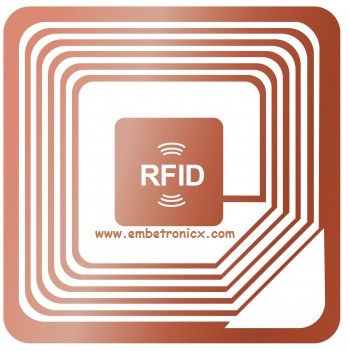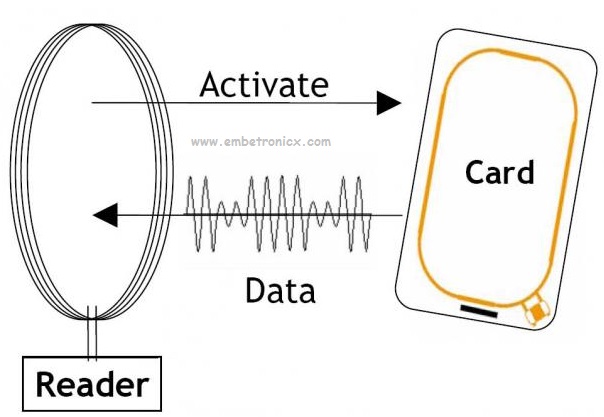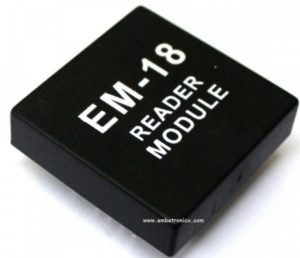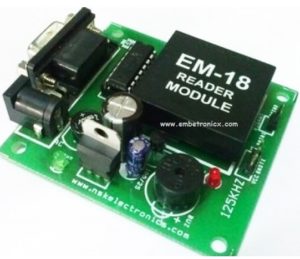If you read this tutorial you will come to know the answer to How Does RFID Works?
You can also read 8051 RFID interfacing, LPC2148 RFID interfacing, and PIC16F877A RFID interfacing.
Table of Contents
Introduction
RFID is an acronym for “Radio-Frequency Identification” and refers to a technology whereby digital data encoded in RFID tags or smart labels (defined below) are captured by a reader via radio waves. RFID is similar to barcoding in that data from a tag or label are captured by a device that stores the data in a database. RFID, however, has several advantages over systems that use barcode asset tracking software. The most notable is that RFID tag data can be read outside the line-of-sight, whereas barcodes must be aligned with an optical scanner.
Applications
- RFID is used in many applications like an attendance system in which every person will have their separate RFID tag which will help identify the person and their attendance.
- RFID is used in many companies to provide access to their authorized employees.
- It is also helpful to keep track of goods and in an automated toll collection system on the highway by embedding Tag (having unique ID) on them.
Components of RFID System
RFID based system has two basic components.
-
RFID Tag
-
RFID Reader
RFID Tags
An RFID tag consists of an integrated circuit and an antenna. This tag carries 12 unique numbers. The tag is also composed of a protective material that holds the pieces together and shields them from various environmental conditions. The protective material depends on the application. For example, employee ID badges containing RFID tags are typically made from durable plastic, and the tag is embedded between the layers of plastic. RFID tags come in a variety of shapes and sizes. Tags can be attached to almost anything like Animals, Employee ID Card, vehicles, assets, Shoes, etc. There are two types of RFID tags.
-
Passive Tags
-
Active Tags
Passive Tags
Passive tags are the most widely used, as they are smaller and less expensive to implement. Passive tags must be “powered up” by the RFID reader before they can transmit data.
|
|
|
Passive tags are comprised of three elements: an integrated circuit or chip, an antenna, and a substrate. The RFID chip stores data and perform specific tasks. Depending on its design, the chip may be read-only (RO), write-once, read-many (WORM), or read-write (RW). Typically, RFID chips carry 96 bits of memory (12Bytes).
Active Tags
Unlike passive tags, active RFID tags have an onboard power supply (e.g., a battery), thereby enabling them to transmit data at all times. Like passive RFID tags, active tags have both a microchip and an antenna. The chips, however, are usually larger in size and have greater capabilities than the RFID chips in passive tags.
RFID Readers
It is used to read unique IDs from RFID tags. Whenever RFID tags come in range, the RFID reader reads its unique ID and transmits it serially to the microcontroller or PC. The RFID reader has a transceiver and an antenna mounted on it. It is mostly fixed in a stationary position.
How Does RFID Works?
RFID Reader has a transceiver that generates a radio signal and transmits it through the antenna. This signal itself is in the form of energy which is used to activate and power the tag.
When the RFID tag comes in a range of signals transmitted by the reader, the transponder in the tag is hit by this signal. A tag draws power from the electromagnetic field created by the reader. Then, the transponder converts that radio signal into usable power. After getting power, the transponder sends all the information it has stored in it, such as a unique ID to the RFID reader in the form of an RF signal. Then, the RFID reader puts this unique ID data in the form of a byte on a serial Tx (transmit) pin. This data can be used or accessed by PC or microcontroller serially using UART communication.
|
|
|
EM18 RFID Reader
This module directly connects to any microcontroller UART or through an RS232 converter to a PC. It gives UART/Wiegand26 output. This RFID Reader Module works with any 125 kHz RFID tags. In our projects and Tutorials, we are going to use this module.
Specifications
-
5VDC through USB (External 5V supply will boost the range of the module)
-
Current: <50mA
-
Operating Frequency: 125Khz
-
Read Distance: 10cm
-
Size of RFID reader module: 32mm(length) * 32mm(width) * 8mm(height)
RS232 interface format
10 ASCII DATA (card no.)+ 2 ASCII DATA (XOR result)
E.g. Card number is 4500C5D1E9B8 read from the reader then the card number on the card will be as below.
|
|
|
45 – Preamble
00C5D1E9 value in Hex = 12964329. / B8 is XOR value for (45 XOR 00 XOR C5 XOR D1 XOR E9)
Hence number on the card is 0012964329.
1. Data baud rate: 9600 bps
2. Data bit 8 bits
3. Parity check: None
4. Stop bit
When we bring the RFID tag near to the reader, it reads the data from the tag and immediately transmits a 12-byte unique ID on the serial port.
12 Byte Unique Identification Number
|
|
|
RFID Tags contain 12 Byte unique IDs.

These checksum bytes will be the XOR result of 1st 10 bytes, i.e. Tag no.
You can also read the below tutorials.
|
|
|

Embedded Software | Firmware | Linux Devic Deriver | RTOS
Hi, I am a tech blogger and an Embedded Engineer. I am always eager to learn and explore tech-related concepts. And also, I wanted to share my knowledge with everyone in a more straightforward way with easy practical examples. I strongly believe that learning by doing is more powerful than just learning by reading. I love to do experiments. If you want to help or support me on my journey, consider sharing my articles, or Buy me a Coffee! Thank you for reading my blog! Happy learning!





